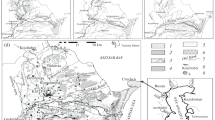Abstract
Determination of hazard zones or potentially unstable zones on the top of sea cliffs to prevent construction in coastal areas is an important issue of coastal management. On the top of the high elevated cliffs in Gurdim, in the Iranian coastline of Gulf of Oman, plants have grown and distributed along the lines parallel to cliff top line likely relating to covered and invisible cracks. In the present study, first, the probable relation between the special distribution pattern of plants and mass movements was assessed according to field observations as well as the correlation between different geometric factors of cliffs and landslides. Then, the potentially unstable zones on top of the cliffs were estimated according to the distribution pattern of plants. Also, the hazard zones were estimated and drawn on top of these cliffs using previous criteria and methods in order to be compared with the unstable zones determined by plants distribution pattern. Finally, some criteria were proposed to estimate the potentially unstable zones for the purpose of coastal management in the northern rocky coastlines of the Gulf of Oman.










Similar content being viewed by others
References
Afarin M, Hamzeh MA, Negarestan H (2015) Sedimentological and geomorphological classification of Chabahar coastal area (Chabahar-Gawater). J Persian Gulf 6:51–66
Arz HW, Lamy F, Pätzold J, Müller PJ, Prins M (2003) Mediterranean moisture source for an early-Holocene humid period in the northern Red Sea. Science 300:118–121
Byrne DE, Sykes LR, Davis DM (1992) Great thrust earthquakes and aseismic slip along the plate boundary of the Makran subduction zone. J Geophys Res-Sol Ea 97:449–478
Carter CH, Guy DE (1988) Coastal erosion: processes, timing and magnitudes at the bluff toe. Mar Geol 84:1–17
Center H (2000) Evaluation of Erosion Hazards. Washington, DC pp 205
Cuyler RH (1931) Vegetation as an indicator of geologic formations. Am Assoc Petrol Geol 15:67–78
Del Río L, Gracia FJ (2009) Erosion risk assessment of active coastal cliffs in temperate environments. Geomorphology 112:82–95
Emery KO, Kuhn GG (1982) Sea cliffs: their processes, profiles, and classification. Geol Soc Am Bull 93:644–654
Gerivani H, Savari S (2019) Influence of wave force direction on cliff profiles: formulation and observation in a case of horizontally layered cliffs in the northern coast of Gulf of Oman. Arab J Geosci 12(16):498
Gerivani H, Stephenson W, Afarin M (2020) Sea cliff instability hazard assessment for coastal management in Chabahar, Iran. J Coast Conserv 24:5
Jongens R, Gibb J, Alloway B (2007) A new hazard zonation methodology applied to residentially developed sea-cliffs with very low erosion rates, East Coast Bays, Auckland, New Zealand. Nat Hazards 40:223–244
Komar PD, McDougal W, Marra J, Ruggiero P (1999) The rational analysis of setback distances: applications to the Oregon coast. Shore and Beach 67:41–49
Lee EM, Clark AR (2002) Investigation and management of soft rock cliffs. Thomas Telford, London, p 382
Marques F (2009) Sea cliff instability hazard prevention and planning: examples of practice in Portugal. J Coastal Res:856–860
Montoya-Montes I, Rodríguez-Santalla I, Sánchez-García MJ, Alcántara-Carrió J, Martín-Velázquez S, Gómez-Ortiz D, Martín-Crespo T (2012) Mapping of landslide susceptibility of coastal cliffs: the Mont-Roig del Camp case study. Geologica Acta 10(4):439–455
Moore LJ, Griggs GB (2002) Long-term cliff retreat and erosion hotspots along the central shores of the Monterey Bay National Marine Sanctuary. Mar Geol 181:265–283
Naylor LA, Stephenson WJ, Trenhaile AS (2010) Rock coast geomorphology: Recent advances and future research directions. Geomorphology 114(1-2):3–11
NRC National Reaserch Center (1990) Managing coastal erosion. National Academies Press, Washington DC, p 182
Page WD, Alt JN, Cluff LS, Plafker G (1979) Evidence for the recurrence of large-magnitude earthquakes along the Makran coast of Iran and Pakistan. Tectonophysics 52:533–547
Prins M, Postma G, Weltje GJ (2000) Controls on terrigenous sediment supply to the Arabian Sea during the late Quaternary: the Makran continental slope. Mar Geol 169:351–371
Regard V, Bellier O, Thomas JC, Bourles D, Bonnet S, Abbassi MR, Braucher R, Mercier J, Shabanian E, Soleymani S, Feghhi K (2005) Cumulative right-lateral fault slip rate across the Zagros—Makran transfer zone: role of the Minab—Zendan fault system in accommodating Arabia—Eurasia convergence in Southeast Iran. Geophys J Int 162:177–203
Reyss J, Pirazzoli P, Haghipour A, Hatte C, Fontugne M (1999) Quaternary marine terraces and tectonic uplift rates on the south coast of Iran. In: Stewart, I.S., Vita-Finzi, C. (Eds.), Coastal
Snead RE (1970) Physical geography of the Makran coastal plain of Iran. Clark Univ, Worcester
Teixeira SB (2006) Slope mass movements on rocky sea-cliffs: a power-law distributed natural hazard on the Barlavento Coast, Algarve, Portugal. Cont Shelf Res 26:1077–1091
Trenhaile AS (1987) The geomorphology of rock coast. Oxford Univ. Press, Oxford, p 384
Acknowledgments
The authors express their sincere gratitude to the Iranian National Institute for Oceanography and Atmospheric Science (INIOAS) for supporting the project.
Author information
Authors and Affiliations
Corresponding author
Additional information
Responsible Editor: Zeynal Abiddin Erguler
Rights and permissions
About this article
Cite this article
Gerivani, H., Savari, S. Using plants distribution pattern to determine potentially unstable zone on the top of sea cliffs in Gurdim (Gulf of Oman, Iran). Arab J Geosci 13, 567 (2020). https://doi.org/10.1007/s12517-020-05605-2
Received:
Accepted:
Published:
DOI: https://doi.org/10.1007/s12517-020-05605-2




